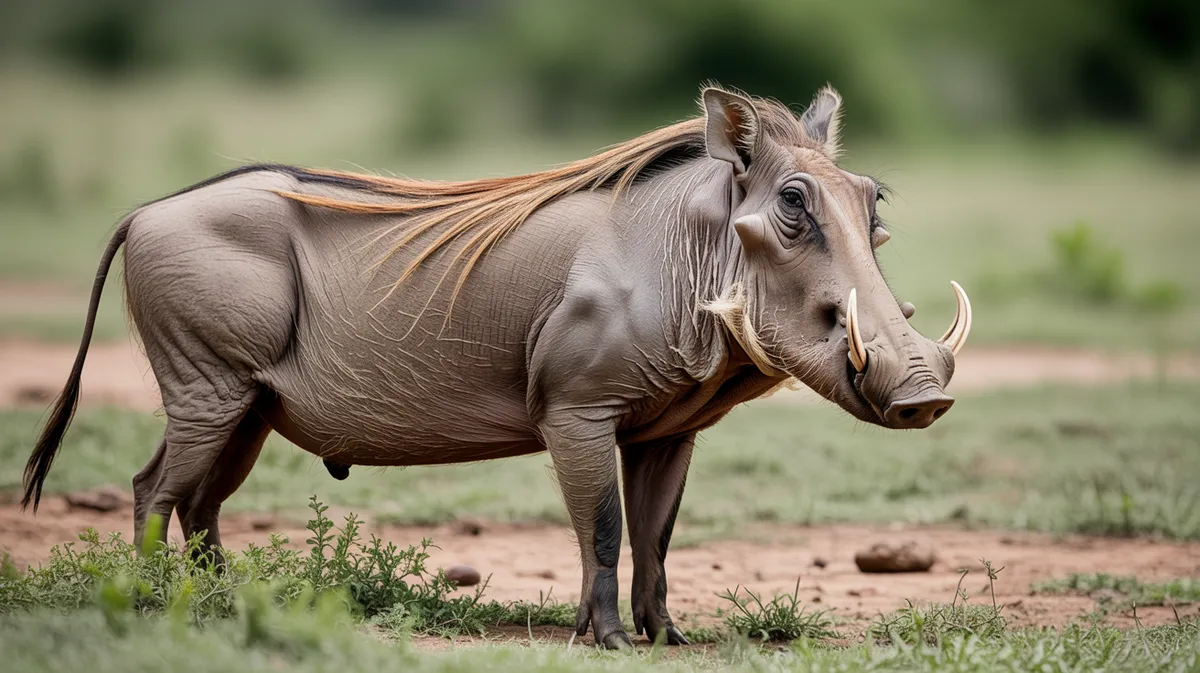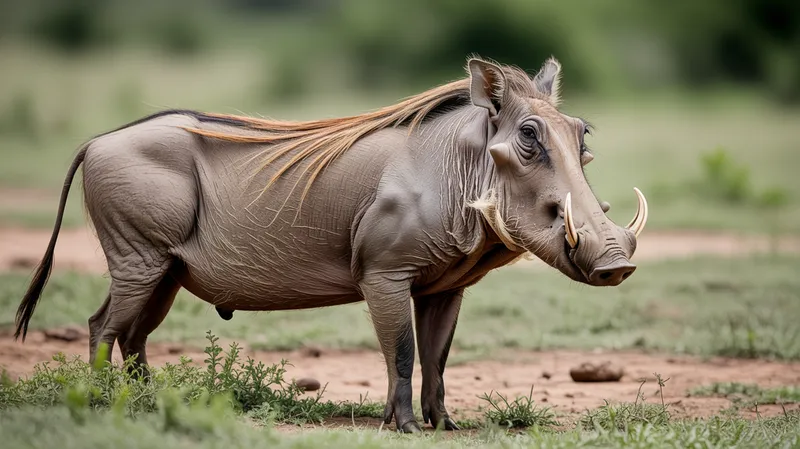
Common Warthog
Phacochoerus africanus

Meet the Common Warthog
The Common Warthog is a wild member of the pig family native to grassland, savanna, and woodland habitats throughout sub-Saharan Africa. Recognizable by its distinctive facial 'warts,' large curved tusks, and sparse bristly hair, the warthog is well-adapted for digging and grazing. They are social animals, often seen in small family groups called sounders, and are known for their unique habit of entering burrows backwards to protect themselves from predators. Agile and surprisingly fast, warthogs are equipped to evade danger and survive in open habitats with minimal cover.
Classification
Mammal
Habitat
Savanna
Diet
Herbivore
Lifespan
7-15 years
Conservation
Least Concern
Weight
50-150 kg
📖Fascinating Facts
Impressive Tusks
Common Warthogs have two pairs of tusks that curve outward and upward, which are used for digging, fighting, and defense against predators.
Fast Sprinters
When escaping danger, warthogs can sprint at speeds up to 48 kilometers per hour, often with their tails held upright as a visual cue to others.
Burrow Dwellers
Warthogs commonly use abandoned burrows, entering them backwards so they can quickly charge out to defend themselves if threatened.
📋Detailed Description
The common warthog (Phacochoerus africanus) is a robust, medium-sized suid characterized by a large head, prominent facial 'warts' (which are actually thickened skin pads), and two pairs of curved tusks protruding from the mouth. Adults typically measure 63–85 cm (25–33 in) at the shoulder and weigh between 50–150 kg (110–330 lb), with males generally larger than females. Their sparse bristly hair, mane along the spine, and tufted tail are distinctive, and their skin is gray to brown, often with patches of bare skin. Warthogs possess a flattened snout adapted for digging and foraging, and their tusks—especially the upper pair, which can reach up to 25 cm (10 in) in length—are used for defense and rooting. Socially, warthogs form matriarchal groups called sounders, typically consisting of females and their offspring, while adult males are more solitary or form bachelor groups. They are diurnal, spending daylight hours grazing and wallowing, and retreating to burrows at night for safety. Warthogs are highly adaptable, capable of surviving in arid and open environments by utilizing abandoned aardvark burrows for shelter and thermoregulation. Their diet is primarily herbivorous, consisting of grasses, roots, bulbs, and occasionally carrion or dung. Notably, warthogs are able to kneel on their calloused forelimbs while grazing, a unique adaptation among suids. Reproduction is seasonal, with synchronized births timed to maximize offspring survival during periods of food abundance.
💡 Did you know?
Despite their tough appearance, warthogs frequently take over abandoned aardvark burrows for shelter and sleep underground.
🔬Research & Sources
Wikipedia Summary
The common warthog is a wild member of the pig family (Suidae) found in grassland, savanna, and woodland in sub-Saharan Africa. In the past, it was commonly treated as a subspecies of P. aethiopicus, but today that scientific name is restricted to the desert warthog of northern Kenya, Somalia, and eastern Ethiopia.
Last Modified: 2/6/2025
🎭Behavior & Social Structure
Common warthogs are primarily diurnal, with peak activity in the cooler hours of early morning and late afternoon. They spend much of their day foraging for grasses, roots, tubers, and occasionally small animals or carrion, using their snouts and tusks to dig. Warthogs often kneel on their calloused wrists while grazing, a behavior that reduces energy expenditure and allows them to access low-growing vegetation. Socially, females and their young form stable sounders of up to 18 individuals, while adult males are more solitary or form loose bachelor groups. Communication includes a range of vocalizations—grunts, growls, and alarm snorts—as well as visual signals such as tail position and body posture. When threatened, warthogs can sprint at speeds up to 48 km/h (30 mph), often entering burrows backwards to present their tusks to potential predators. They wallow in mud to regulate body temperature and deter parasites, and are known to use communal latrines for scent marking. Warthogs are also opportunistic, sometimes following other animals to exploit disturbed soil or water sources.
👶Reproduction & Life Cycle
Breeding in common warthogs is typically seasonal, with mating occurring at the end of the rainy season and births synchronized with the onset of the next rainy period, ensuring abundant food for piglets. Females reach sexual maturity at about 19–20 months, while males mature slightly later. After a gestation period of approximately 5–6 months (about 170–175 days), females give birth to litters of 2–8 piglets, with 2–4 being most common. Births occur in secluded burrows, which provide protection from predators. Piglets are weaned at around 3–4 months but may begin grazing as early as two weeks old. Maternal care is pronounced, with females fiercely defending their young and leading them to new burrows if threatened. Females may use multiple burrows during the rearing period to reduce predation risk. Juveniles remain with the mother for up to two years, after which males disperse while females may stay with the natal group.
🛡️Adaptations & Survival
The common warthog exhibits several key adaptations for survival in open and arid habitats. Its flattened snout and strong neck muscles facilitate efficient digging for roots, bulbs, and tubers, which are critical food sources during dry periods. The thickened facial 'warts' protect against bites during fights, particularly among males competing for mates. Calloused pads on the wrists enable the warthog to kneel while feeding, reducing energy expenditure and wear on the limbs. Their sparse hair and mud-wallowing behavior aid in thermoregulation and parasite control. The habit of using and modifying abandoned burrows for shelter provides protection from predators and extreme temperatures. Warthogs have an excellent sense of smell and hearing, compensating for relatively poor eyesight, and their high reproductive rate allows rapid population recovery after losses.
📚Research Sources
🎨Cultural Significance
Warthogs feature in various African folklore and traditional beliefs, often symbolizing resilience, resourcefulness, and tenacity. In some cultures, warthog tusks are used as amulets or in traditional medicine, believed to confer strength or protection. Their image is commonly found in African art and crafts, and they are a popular subject for wildlife tourism and photography. In modern culture, the warthog has gained international recognition through media, notably as the character 'Pumbaa' in Disney's 'The Lion King,' which has contributed to a positive public perception. However, in agricultural communities, warthogs are sometimes viewed as pests due to crop raiding.
🔬Recent Research & Discoveries
Recent research on common warthogs has focused on their role as ecosystem engineers, particularly their use of burrows and impact on soil turnover. Studies have examined their social structure, vocal communication, and anti-predator strategies, including the use of burrows and group vigilance. Genetic analyses have clarified subspecies boundaries and evolutionary relationships within the genus Phacochoerus. Ongoing research investigates warthog susceptibility to diseases shared with domestic pigs, with implications for livestock management. There is growing interest in their behavioral flexibility and adaptability to human-modified landscapes, as well as their interactions with other species, such as symbiotic relationships with birds that remove ectoparasites.
🎥Wildlife Videos

Warthogs - Africa's Wild Wonders - Go Wild
Africa's bushpig may be nothing pretty to look at! But these ugly beasts are adapted survivors to Africa's harsh environs. From their ...
Go Wild

One Tough Warthog | Deadly Instincts
#NatGeoWILD #Warthog #DeadlyInstincts About National Geographic Wild: National Geographic Wild is a place for all things ...
Nat Geo Animals

How Lioness Take Over the Lead in the Warthog Hunt | Our World
TALES FROM THE WILD takes some of the most spectacular wildlife moments ever caught on film from the Survival Archive and ...
Our World

Warthog is More Powerful Than Cheetahs , And Here is The Proof
Note : This content is mixed between fact and fiction. Sometimes we create fictional stories, where we combine a few clips to ...
BUZZBIBLE VIDÉO

This Warthog took a trip to the Mongoose Spa | Banded Brothers - BBC
Banded Brothers | Series 1 Episode 1 | BBC #BBC #BandedBrothers #MongooseSpa.
BBC

Wild Tales: The Common Warthog Expedition #nature #animals #wildlife #animalfacts #natureexploration
Embark on a thrilling safari with our YT Shorts film, "Wild Tales: The Common Warthog Expedition." Discover the fascinating world ...
Animal Facts Hub
🌍Habitat Information
The Common Warthog typically inhabits Savanna environments. Common Warthogs have adapted to their environments with specialized features and behaviors.
Primary Habitat:
Savanna
More detailed habitat information will be available soon.
🛡️Conservation Status
The Common Warthog is currently classified as Least Concern. Conservation efforts are crucial for preserving this species for future generations.
Common Threats:
- 🏠Habitat loss and fragmentation
- 🌡️Climate change impacts
- 🎯Hunting and poaching
- 🏭Human-wildlife conflict
⚠️Threats & Conservation Challenges
Despite being classified as Least Concern by the IUCN, common warthogs face several localized threats. Habitat loss due to agricultural expansion, human settlement, and fencing can restrict movement and access to resources. They are hunted for bushmeat and sometimes persecuted as crop pests. Warthogs are susceptible to diseases such as African swine fever and foot-and-mouth disease, which can impact populations and livestock. Predation by lions, leopards, hyenas, and crocodiles is a natural mortality factor, especially for juveniles. However, their adaptability, high reproductive output, and use of burrows contribute to population resilience. In some regions, warthogs benefit from human-altered landscapes, such as cleared land and waterholes, which can increase local densities.
🔬Scientific Classification
Scientific Name
Phacochoerus africanus
Classification Hierarchy
🔍 About Taxonomic Classification
Taxonomic classification is a hierarchical system used by scientists to classify and organize living organisms based on shared characteristics and evolutionary relationships.
The system moves from broad categories (Kingdom) to increasingly specific ones, with each animal's scientific name typically consisting of its Genus and species.
📝Community Notes
Share your observations and insights about the Common Warthog with our community of wildlife enthusiasts.
Join Our Community
Sign in to share your observations and connect with fellow wildlife enthusiasts.
Sign In to ContributeNo community notes yet
Be the first to share your observations about the Common Warthog!
Explore Common Warthog
Select a tab above to learn more about this amazing animal.
📸Photo Gallery
No photos available for this animal yet.
🌟Discover More Wildlife
Continue your journey of discovery with more fascinating animals from our database
